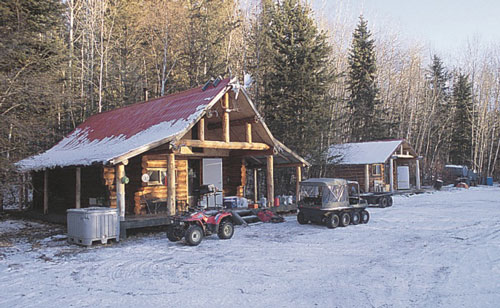Previously: Wearing The Right Stuff
Warm Shelter, Dependable Transport
 Just as I had spent substantial time and effort in getting prepared for my hunt, it was good to see Bateman had done the same with provisions for camp. Though just 36 at the time, Bateman was an experienced Alberta woodsman with plenty of trophy bow-bagged animals to his credit and even more “bush country” know-how, specifically when it comes to hunting comfort. The log cabins we used, located on the banks of the sprawling Athabasca River, were new, solid, and warm with dependable wood-burning stoves and plenty of space for gear. A main cabin even held a hot shower—a luxury in camps this remote.
Just as I had spent substantial time and effort in getting prepared for my hunt, it was good to see Bateman had done the same with provisions for camp. Though just 36 at the time, Bateman was an experienced Alberta woodsman with plenty of trophy bow-bagged animals to his credit and even more “bush country” know-how, specifically when it comes to hunting comfort. The log cabins we used, located on the banks of the sprawling Athabasca River, were new, solid, and warm with dependable wood-burning stoves and plenty of space for gear. A main cabin even held a hot shower—a luxury in camps this remote.
The highlight of the camp, however, was Bateman’s fleet of Argos. These ATVs have eight wheels and float, offering unlimited access down narrow, twisting trails or while crossing creeks. Better still was the fact Bateman had equipped them with optional enclosed, heated cabs. In some cases we were traveling up to seven miles from camp to a hot stand site—an impossibly long, cold ride during below-zero mornings on a standard, unprotected ATV. Since full-size pickups and similar vehicles couldn’t even make it back to the camp due to long stretches of unstable bog, the Argos were the ideal answer.
Case in point came during my first full day on stand, which ended up being just that. Arising to an icy, crisp morning, it wasn’t long before we were motoring down the main trail from camp, headed toward a pipeline cutline 45 minutes away. Once there Bateman led me—still toasty warm thanks to the Argo—to a field-edge stand at the back corner of the field, near an abandoned, oil drilling station. I didn’t have to ask why. Deer tracks were everywhere, but especially cutting near a broken-down fence that stretched a mere 25 yards from my stand tree.
“Shoot straight, and remember to let those 120-class bucks pass, it’s just your first day,” Bateman finally hissed, then turned and left.
See page 2 for more.
Encounters, But Not Close Enough
What ensued that day I still can’t recall without cracking a sly smile. From about 9 a.m. until noon, there was constant buck activity in the field. Nearly all of them emerged from a brushy draw just to the south, several hundred yards away. Then, they’d cross the large open field on a virtual crash-course with my treestand. All of them passed within 20 yards, including one 120-class 8-pointer that I then called back using a rattling bag. It never did locate the source of the sound, finally tiring of the game after it was called back twice. It didn’t take long for further action.
Bateman, unsure of the cold and my endurance, had promised to check back at noon. I had to wave him off, as I could see him sneaking toward me in the distance—over the heads of two bucks sparring in the field, just 35 yards from my stand. The largest, a decent 130-class 8-point with tall, white tines seemed a little too far and too active to risk a shot. I passed, then ended up questioning whether I’d made the right decision. Despite the lengthy dark-to-dark vigil, that 8-pointer was the last deer spied all day.
Three real lifesavers—which proved themselves mightily during that first day and the next when I returned to the same field—proved to be a pee bottle, a couple high-energy bars, and a collapsible canteen. Compact and flat enough to keep slung over my shoulder under my coat, the move prevented the water from freezing in temps that could have done the job in mere minutes.
A little energy was just what the doctor ordered when, after a lull in the action late in the afternoon on Day 2, I grabbed a bite of bar and settled in for a little rattling. It was only five minutes later when I heard brush crackling behind me, then snuck a peek to glimpse the approach of a fine 140-class 10-point. Obviously on alert, the heavy-beamed buck angled around to my left, staying in the thick brush while scanning the open field for the combatants. Then, apparently satisfied the coast was clear, it stepped out at 45 yards and turned away, looking exactly like a large 3-D target. Again I was tempted but convinced myself to wait for a better shot. It was not to be.
Back at camp that night I explained how the buck turned and drifted back into the brush, coming no closer. That was enough to prompt discussion of Plan B, which would take advantage of the apparent aggressive nature of these late-rut bucks.
Next: “Jurassic” Trophy Buck






